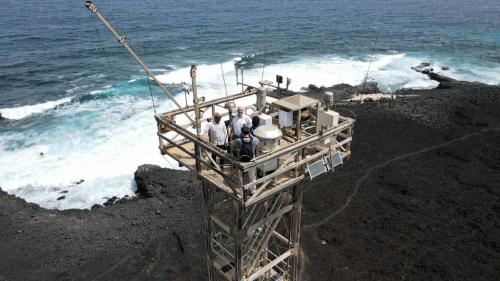National Facilities


The international Cape Verde Atmospheric Observatory (CVAO) is being further expanded: The President of the Republic of Cabo Verde José Maria Neves and German President Frank-Walter Steinmeier laid the foundation for a new laboratory building on São Vicente, one of the Cape Verde Islands off Africa, and inaugurated a new remote sensing station. The island in the tropical Atlantic has become an international focal point of climate research in recent years. The atmospheric observatory has therefore now become part of the European research infrastructure ACTRIS. It is jointly operated by a consortium of the Cape Verde Institute for Meteorology and Geophysics (INMG), the Leibniz Institute for Tropospheric Research (TROPOS) in Leipzig, the Max Planck Institute for Biogeochemistry in Jena (MPI-BGC) and the University of York in the UK. The investments in new rooms and technology are being funded by the German Federal Ministry of Education and Research (BMBF) with over 3 million euros as part of Germany's ACTRIS-D contribution. Germany is thus greatly intensifying its research cooperation with the Republic of Cabo Verde and providing important data from a key region of global climate change.
“The existing in-situ measurements of aerosols will be expanded and modernised: New equipment can measure the light scattering of particles, the chemical composition and the content of trace metals as well as cloud condensation nuclei in real time. In the future, the automation of aerosol and cloud water samples will ensure that the data is available much faster than before," explains Prof. Hartmut Herrmann from TROPOS, the scientific director of the CVAO and the Atmospheric Chemistry Department (ACD) of TROPOS. "The new laboratory building for the CVAO will significantly improve the investigation possibilities for dust and marine aerosol particles. The CVAO will thus be strengthened and attractive for guest users.”
The in-situ measurements in Calhau are now complemented by remote sensing measurements in Mindelo: On the roof of the Ocean Science Centre Mindelo (OSCM), a new station was built in cooperation with the German GEOMAR Helmholtz Centre for Ocean Research Kiel and the Cape Verdean Instituto do Mar, which investigates particles in the atmosphere up to a height of 30 kilometres. For this purpose, a lidar device developed by TROPOS was installed in 2021, whose laser has already made an important contribution to the validation of the ESA wind satellite Aeolus. The lidar was supplemented in 2023 by instruments for remote cloud sensing: a microwave radiometer, a wind lidar and a cloud radar. Likewise, instruments for measuring solar and thermal radiative fluxes were installed to determine the influence of aerosols and clouds on the radiative forcing of the atmosphere and ocean. With these additions, this ACTRIS station is now complete and officially began operations for the visit of the German President on 5 October 2023. "The station will also serve as a reference station for the Earth observation satellite EarthCARE, which the European ESA and the Japanese JAXA plan to launch in 2024 to study aerosols and clouds and their influence on radiation in the Earth's atmosphere," explains Prof. Andreas Macke, Director of TROPOS and Head of the Remote Sensing Department.
Press release: link
Photo & video gallery: link
Photo Credit: Edson Silva Delgado, GEOMAR












